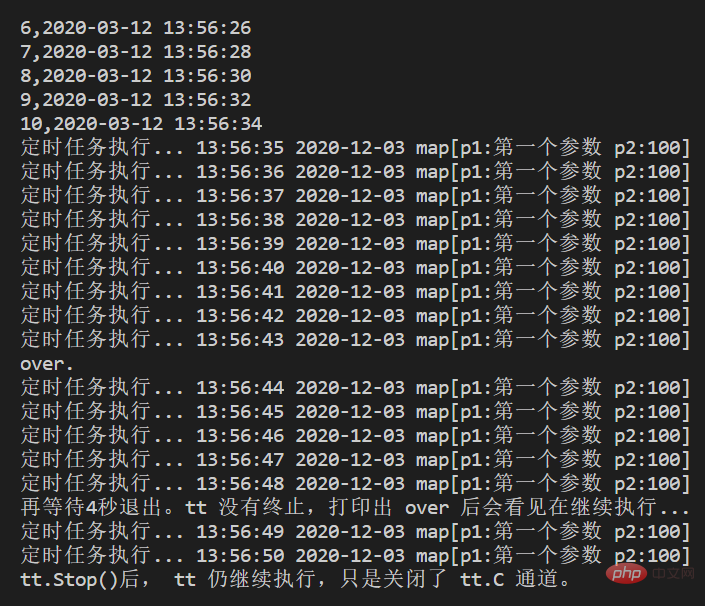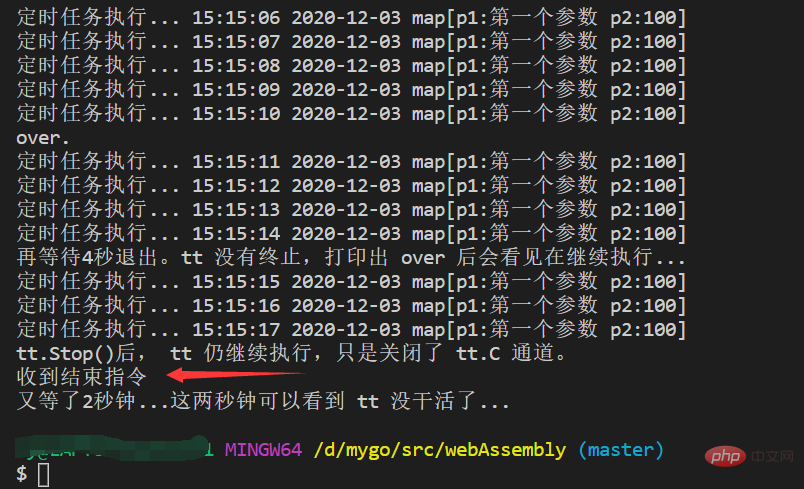go语言设置定时器的方法:1、通过“time.NewTicker()”方法创建,其中ticker会按照设定的间隔时间触发;2、通过“time.NewTimer()”方法创建,其中timer只会执行一词;3、使用“After()”来创建。

本文环境:Windows7系统、Go1.11.2版,本文适用于所有品牌的电脑。
推荐:《golang教程》
Go语言中定时器的使用
GO语言在time包中提供了三种定时器的使用方式:
立即学习“go语言免费学习笔记(深入)”;
1.第一种:ticker
// A Ticker holds a channel that delivers `ticks' of a clock
// at intervals.
type Ticker struct {
C <-chan Time // The channel on which the ticks are delivered.
r runtimeTimer
}通过 time.NewTicker() 创建,这种类型,ticker会不断的按照设定的间隔时间触发,除非主动终止运行。
2.第二种:timer
// The Timer type represents a single event.
// When the Timer expires, the current time will be sent on C,
// unless the Timer was created by AfterFunc.
// A Timer must be created with NewTimer or AfterFunc.
type Timer struct {
C <-chan Time
r runtimeTimer
}通过 time.NewTimer() 创建,这种类型,timer只会执行一次,当然,可以在执行完以后通过调用 timer.Reset() 让定时器再次工作,并可以更改时间间隔。
3.第三种:After()
// After waits for the duration to elapse and then sends the current time
// on the returned channel.
// It is equivalent to NewTimer(d).C.
// The underlying Timer is not recovered by the garbage collector
// until the timer fires. If efficiency is a concern, use NewTimer
// instead and call Timer.Stop if the timer is no longer needed.
func After(d Duration) <-chan Time {
return NewTimer(d).C
}从代码可以看到,After()其实是Timer的一个语法糖。
下面通过代码演示一下三种方式的使用:
1.Ticker
ticker := time.NewTicker(time.Second * 1) // 运行时长
ch := make(chan int)
go func() {
var x int
for x < 10 {
select {
case <-ticker.C:
x++
fmt.Printf("%d\n", x)
}
}
ticker.Stop()
ch <- 0
}()
<-ch // 通过通道阻塞,让任务可以执行完指定的次数。该ticker每1秒触发一次,即ticker.C中每一秒会有一个内容加入,最后通过向ch中写入数字,让程序解除阻塞,继续执行。
2.Timer
timer := time.NewTimer(time.Second * 1) // timer 只能按时触发一次,可通过Reset()重置后继续触发。
go func() {
var x int
for {
select {
case <-timer.C:
x++
fmt.Printf("%d,%s\n", x, time.Now().Format("2006-01-02 15:04:05"))
if x < 10 {
timer.Reset(time.Second * 2)
} else {
ch <- x
}
}
}
}()
<-ch3.After()
// 阻塞一下,等待主进程结束
tt := time.NewTimer(time.Second * 10)
<-tt.C
fmt.Println("over.")
<-time.After(time.Second * 4)
fmt.Println("再等待4秒退出。tt 没有终止,打印出 over 后会看见在继续执行...")
tt.Stop()
<-time.After(time.Second * 2)
fmt.Println("tt.Stop()后, tt 仍继续执行,只是关闭了 tt.C 通道。")4.我们可以利用这些基本的方法,设计自己的定时任务管理。
type jobFunc2 func(j *job)
type job struct {
jf jobFunc2
params map[string]interface{}
ch chan int
}
func NewJob() *job {
return &job{
params: make(map[string]interface{}),
ch: make(chan int),
}
}
func (j *job) Run(t time.Duration) {
ticker := time.NewTicker(time.Second * t)
go func() {
for {
select {
case <-ticker.C:
j.jf(j)
case <-j.ch:
fmt.Println("收到结束指令")
ticker.Stop()
break
}
}
}()
}
func main() {
j := NewJob()
j.jf = func(jj *job) {
fmt.Println("定时任务执行...", time.Now().Format("15:04:05 2006-02-01"), jj.params)
}
j.params["p1"] = "第一个参数"
j.params["p2"] = 100
j.Run(1)
// 阻塞一下,等待主进程结束
tt := time.NewTimer(time.Second * 10)
<-tt.C
fmt.Println("over.")
<-time.After(time.Second * 4)
fmt.Println("再等待4秒退出。tt 没有终止,打印出 over 后会看见在继续执行...")
tt.Stop()
<-time.After(time.Second * 2)
fmt.Println("tt.Stop()后, tt 仍继续执行,只是关闭了 tt.C 通道。")
}部分执行结果截图:

最后补充一下,通过channel去终止任务的执行。
// 阻塞一下,等待主进程结束
tt := time.NewTimer(time.Second * 10)
<-tt.C
fmt.Println("over.")
<-time.After(time.Second * 4)
fmt.Println("再等待4秒退出。tt 没有终止,打印出 over 后会看见在继续执行...")
tt.Stop()
<-time.After(time.Second * 2)
fmt.Println("tt.Stop()后, tt 仍继续执行,只是关闭了 tt.C 通道。")
j.ch <- 0
<-time.After(time.Second * 2)
fmt.Println("又等了2秒钟...这两秒钟可以看到 tt 没干活了...") 
在GO语言编写中,要熟练使用 channel。
以上就是go语言如何设置定时器的详细内容,更多请关注php中文网其它相关文章!

每个人都需要一台速度更快、更稳定的 PC。随着时间的推移,垃圾文件、旧注册表数据和不必要的后台进程会占用资源并降低性能。幸运的是,许多工具可以让 Windows 保持平稳运行。

Copyright 2014-2025 https://www.php.cn/ All Rights Reserved | php.cn | 湘ICP备2023035733号